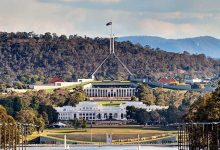While Federal parliament enters yet another phase of confusing discourse on energy and climate change policy, and the ruling government buries itself deeper and deeper into climate and energy denial, the capital city in which parliament sits is poised to enter a select club of world-leading jurisdictions successfully making the switch to 100% renewable electricity.
Research published by The Australia Institute on Wednesday notes that from October 1, the Australian Capital Territory will become the first jurisdiction outside of Europe, with a population greater than 100,000 people, to reach the milestone of sourcing the equivalent of 100% of its electricity needs from renewable energy sources, and just the eighth globally.
Seven cities across Germany, Austria and Spain have all made the switch to 100% renewable electricity, with more than 100 cities, states and countries with the same ambition of sourcing all of their power from renewables in the near future.
A further four jurisdictions, from Netherlands, Sweden, Norway and Uganda, are set to reach the 100% goal within the next year.
This means that Canberra joins a select club of cities that have made the switch away from an electricity supply powered primarily by fossil fuels to one powered by completely by zero-emissions renewable energy sources.

To reach the 100% target, the ACT contracted to purchase electricity from five wind farms and three solar farms, with a combined capacity of 640MW. All of the projects are additional to the Federal renewable energy target, ensuring the projects have helped to grow the overall level of renewable energy production in Australia.
“The ACT is a renewable energy trailblazer. Achieving 100% renewable status shows what governments can achieve with strong climate and energy policy,” The Australia Institute’s climate and energy program director Richie Merzian said.
“This shows that states and territories are leading the way on climate action while national governments often lag behind. Australia is a perfect example.
“While some federal parliamentarians are trying to hit the brakes Australia’s energy transition, even Parliament House will soon run on 100% renewable energy.”
Electricity from the last project needed for the ACT to reach its 100% renewable electricity goal will be supplied in October when the 109MW third stage of the Hornsdale Wind Farm starts to deliver on its contract. (The wind farm is already operating and selling on the open market, but the contract with the ACT only starts next month).
While the ACT is a comparatively small jurisdiction in Australia, the contract-for-difference model used by the ACT Government to secure additional supplies of renewable electricity is one that has been adopted by jurisdictions, including Victoria, South Australia and Queensland and several local government authorities.
In July, recognising his work on designing and implementing the scheme that provided a crucial lifeline to the sector, previous ACT energy minister Simon Corbell was awarded the Clean Energy Council’s award for outstanding contribution to the clean energy sector.
The ability for such contracts to effectively shield electricity buyers from surges in wholesale electricity prices has also made them an attractive option for corporate electricity users, and underpin many of the corporate power purchase agreements secured in recent years.
The research comes as the ACT releases the new phase of its strategy for tackling climate change and sets its sights on reducing greenhouse gas emissions parts of the economy beyond the electricity sector.
In an ambitious plan released earlier in the week, the ACT Government revealed that it will target natural gas use in the territory, effectively pledging to phase out the use of gas under its zero net emissions goal by 2045.
The ACT will seek to reduce emissions across the transport sector, by supporting increased use of public transport alternatives and the purchase of zero-emissions vehicles and will explore the potential of running ‘car-free’ days to encourage Canberra residents to reduce their reliance on cars.
The ACT Government has also announced that it is seeking proposals for up to 250MW in additional renewable electricity supply, to ensure the ACT maintains its 100% renewable electricity status into the future, particularly as the territory seeks to shift more of its fossil fuel consumption onto the electricity grid.
The reverse auction model used by the ACT to secure supply from new renewable energy projects, which uses a ‘contract-for-difference’ approach to fixing the price of electricity paid to the projects, has worked to shield ACT consumers from surging wholesale electricity prices.
In fact, the contracts have worked so well, that analysis from wind engineer David Osmond has found the contracts left ACT consumers better off, effectively delivering negative feed-in-tariff payments that have made electricity cheaper compared to ACT households simply purchasing their power from the grid.
The cost of the ACT's 100% renewable target was negative $4.3 millon in the first quarter of 2019. So rather than costing ACT consumers, it saved them money! Data from https://t.co/DnNER0LvYB pic.twitter.com/l2vHcgrcLa
— David Osmond (@DavidOsmond8) September 17, 2019
Additionally, analysis from Osmond has shown that while the renewable energy projects supplying the ACT are scattered across NSW, Victoria and South Australia, the diversity of wind and solar projects does a surprisingly good job at matching Canberra’s energy demand profile before energy storage is included.
The research further highlights the discrepancy between what the ACT Government has been able to achieve with ambitious policies for clean energy adoption and greenhouse gas emissions reduction targets and the ongoing failure of the Federal government to effectively legislate meaningful and lasting policies on the same.
This week, the Federal Coalition government tabled a revived version of its ‘big stick’ energy policy, which would provide the government new powers to potentially break up energy policies that do not adhere to its expectations, with fears the powers could be used to prop up ageing coal-fired generators that would otherwise be closed by their owners.










